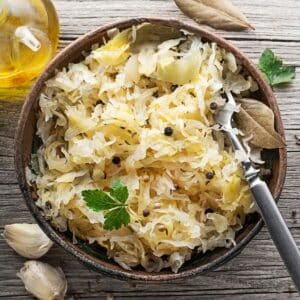
Traditional Sauerkraut
Experience the authentic flavor of traditional sauerkraut with this homemade recipe. Ferment cabbage the traditional way and elevate your meals with this classic accompaniment.
Ingredients
- 2 heads of cabbage approximately five lbs
- ¼ cup salt refer to note below
- 1 tablespoons caraway seeds optional (1-2 tbs)
Instructions
Prep and Clean:
- Begin by ensuring that all equipment, work surfaces, and your hands are thoroughly cleaned.
- Wash everything with warm soapy water to create a sanitary environment for fermentation.
Prepare the Cabbage:
- Remove the outer leaves and cores from the cabbage. You can compost the discarded parts.2 heads of cabbage
- To facilitate slicing, cut the cabbage into quarters. Then, thinly slice the cabbage into delicate ribbons. Using a food processor can expedite this slicing process.
Salt the Cabbage:
- Place the thinly sliced cabbage into a clean, large bowl.
- Evenly sprinkle the salt over the cabbage.¼ cup salt
- Now, using your hands, knead and squeeze the cabbage and salt together for about ten minutes.
- Initially, you might not notice much change, but be patient. After a few minutes, the cabbage will start releasing liquid, and by the end, there should be enough brine to submerge the cabbage in the fermentation vessel.
- If desired, add the caraway seeds at this stage.1 tablespoons caraway seeds
Transfer to Fermentation Container:
- Pack the cabbage tightly into your chosen fermentation jars or crock.
- Pour any liquid from the bowl into the container.
- If necessary, add a bit of water to ensure that the cabbage is completely covered by the liquid brine.
- If the cabbage is particularly fresh and juicy, additional water may not be needed.
Apply Weight and Cover:
- Place the fermentation weights on top of the cabbage to keep it submerged under the brine.
- Seal the container with the fermentation lid, or follow the specific instructions for your fermentation crock.
- Alternatively, if using a basic mason jar, you can place a smaller jar inside the lid, then cover both jars with a cloth secured by a rubber band.
Commence Fermentation:
- Patience is key now. Fermentation will initiate within a day and can take anywhere from 2 to 5 weeks, depending on the ambient temperature and the level of tartness you desire. Around the 2-week mark, start tasting the sauerkraut to determine if it has reached your preferred level of flavor.
Cool and Store:
- Once the sauerkraut has reached your desired taste, it can be consumed immediately. Alternatively, store it in the refrigerator where it will keep for up to six months
Notes
- Though some fermentation occurs within a few days, the optimal taste seems to develop between 2 to 3 weeks. During fermentation, you may notice bubbles, white scum, or foam on the surface. This is normal. If any mold appears, remove it carefully, ensuring the rest of the cabbage is fully submerged below the brine level. The cabbage under the brine should remain unaffected.
Nutrition
Calories: 237kcalCarbohydrates: 54gProtein: 12gFat: 1gSaturated Fat: 0.3gPolyunsaturated Fat: 0.3gMonounsaturated Fat: 0.4gSodium: 14311mgPotassium: 1587mgFiber: 24gSugar: 29gVitamin A: 901IUVitamin C: 333mgCalcium: 393mgIron: 5mg
Tried this recipe?Let us know how it was!